Geographical Distribution in Africa
Geographical Distribution of the Cabbage looper in Africa (red marked). Updated on 10 July 2019. Source CABI
General Information on Pest and Damage
Introduction
The cabbage looper is widely distributed in the tropics and subtropics. It is a serious pest of cruciferous crops, but it also attacks other important crops such as tomato, lettuce, potatoes, sweet potatoes, cotton, cucurbits, etc. The cabbage looper is somewhat erratic in occurrence, typically very abundant one year, and then scarce for two to three years.
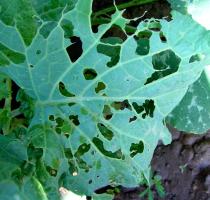 |
|
Damage caused by cabbage looper on kales |
|
© A. M. Varela, icipe
|
Damage
Caterpillars feed primarily on leaves and cause irregular holes. Young caterpillars eat small holes, but older caterpillars feed on the tissue between the veins skelotinising the leaves (leaving only the midribs and veins) or giving them a ragged appearance. Plants can be severely defoliated and stunted, producing no heads or becoming unfit for consumption. They may also bore into the heads of lettuce and cabbage, contaminating them with frass. The presence of caterpillars and contamination of marketable plant parts with frass reduce the market value of the produce. Thus, large amounts of dark green pellets excreted by the feeding looper may stain cauliflower heads. The presence of cabbage looper caterpillars in broccoli heads renders them unmarketable.
Host range
The cabbage looper has a wide host range that includes crucifers, beans, cotton and various vegetable crops. It is listed as feeding on over 160 species of plants in 36 families, but cultivated crucifers are preferred.
Affected plant stages
Vegetative growing stage.
Affected plant parts
Leaves and whole plant.
Symptoms by affected plant part
Leaves: external feeding; internal feeding; webbing; frass visible; shredding.
Whole plant: plant death; dieback; dwarfing; internal feeding; external feeding; frass visible.
Biology and Ecology of the Cabbage Looper
The eggs are round or slightly dome-shaped with ridges, and about the size of a pinhead. They are pearly or silvery white and darken when they age. Eggs are laid singly usually on the undersides of leaves. A female moth can lay from 300 to 1600 eggs. Caterpillars hatch in 2 to 6 days after the eggs were laid.
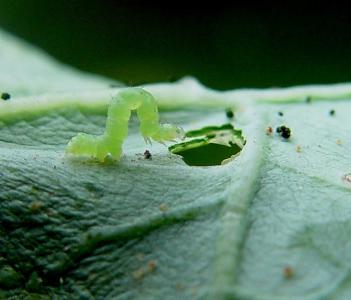 |
|
Young cabbage looper feeding on a kale leaf. Mature caterpillar reaches 3 to 4 cm in length. |
|
© A. M. Varela, icipe
|
The caterpillars go through five instars during development. Very young caterpillars are white and almost clear with a black head capsule. Older caterpillars are green with a thin white line on each side just above the spiracles and two other white lines on the dorsum. Caterpillars have three pairs of legs near the head and three sets of prolegs (false legs) near its rear. They move in a "looping" manner, arching the middle portion of the body as they move forward. Fully-grown caterpillars reach 3 to 4 cm in length.
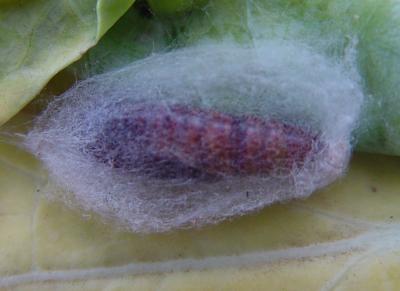 |
|
Pupa of the cabbage looper. During its last larval stage the caterpillar spins a cocoon. |
|
© A. M. Varela, icipe
|
Pupa. Caterpillars pupate in white loose cocoons attached to the underside of leaves, or in a folded webbed leaf or between two webbed leaves. The pupae are light green when young and gradually turn dark brown when mature. The moths are light green when young and gradually turn dark brown when mature. The moths emerge from the pupae 10 to 16 days after pupation.
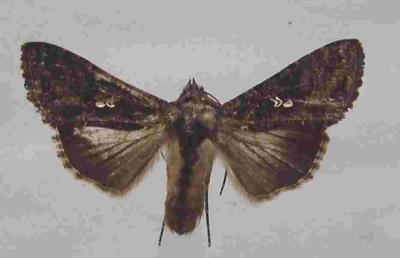 |
|
Moth of the cabbage looper. Real size: ca 2.5 cm in length, wingspan is ca. 4 cm |
|
© A. M. Varela, icipe
|
The adult is a mottle, greyish-brown moth, about 2.5 cm long and with a wingspan of 4 cm. The front wings have two small silvery spots, one small and round, the other U-shaped (resembling an '8'), near the middle part of the wing. The hind wings are pale brown. Cabbage looper moths are strong fliers and are primarily nocturnal. During the day the moths can be found resting in foliage or in crop debris. Development from egg to adult takes about 4 to 6 weeks
Pest and Disease Management
Pest and disease Management: General illustration of the concept of Infonet-biovision
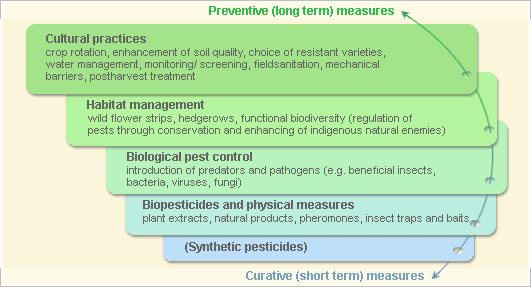

This illustration shows the methods promoted on infonet-biovision. The methods shown at the top have a long-term effect, while methods shown at the bottom have a short-term effect. In organic farming systems, methods with a long-term effect are the basis of crop production and should be of preference. On the other hand methods with a short-term effect should be used in emergencies only. On infonet we do not promote synthetic pesticides.
Further below you find concrete preventive and curative methods against Cabbage looper.
Cultural practices
Monitoring
Inspect plant regularly for the presence of caterpillars, leaf damage and the presence of frass. Caterpillars can be detected by scouting the crop, while adults can be monitored by using light- or pheromone-baited traps.
Monitor the presence of natural enemies. They play an important role in controlling the cabbage looper. Check plants twice a week once seedling emergence begins. When populations appear to be increasing, check more often.
Treatment thresholds vary depending on the crop and location. Normally, spraying should not occur when there is less than 1 caterpillar per 5 plants (CABI, 2000). A control measure is not necessary unless you find more than 9 small to medium-sized caterpillars per plant.
Management options
1. Plant resistant varieties, if available. Some resistant varieties are "Mammoth Red Rock", "Chieftan Savoy", and "Savoy Perfection Drumhead". Ask for assistance from local agriculture office to obtain cabbage looper resistant cultivars that are available in the local markets.
2. Remove and destroy all the plant debris after harvest. The pupae might still be present in the plants. Plough and harrow the field after harvest.
3. Clear the surrounding area of weeds, which may serve as alternative hosts for the pests.
Biological pest control
Natural enemies
Natural enemies usually keep the pest populations at low levels and control measures are not often needed. Therefore, their conservation is very important. Avoid using broad-spectrum pesticides for the control of this or other pests. Cabbage looper infestations often increase after use of broad-spectrum pesticides due to elimination of natural enemies.
A wide range of natural enemies attacks the cabbage looper: predators, egg and larval parasitoids (parasitic wasps) and pathogens (Bt and viruses).
Egg predators and parasitoids are important since they kill eggs preventing any subsequent damage by caterpillars.
The nuclear polyhedrosis virus is particularly important in controlling this pest. The virus occurs naturally in the soil or on plants in most crop areas. Virus-infected insects can be reintroduced into the field by collecting diseased insects, mixing them in a blender, filtering out large tissue masses and then spraying the virus particles back onto the field.
Biopesticides and physical methods
Bt (Bacillus thuringiensis)
Bt products give good control of the cabbage looper, and do not harm natural enemies. For optimum control, treatments should be applied when caterpillars are small. Frequent crop monitoring is helpful to know the optimal time to apply Bt and other insecticides. For more information on Bt click here
Neem
Neem-based pesticides are reported to control the cabbage looper by interfering with the growth of young caterpillars. Fairly good control of this pest has been obtained with a 2% ethanolic extract of neem seeds (Ostermann and Dreyer, 2000). For more information on neem click here.
Physical control methods
1. Handpick the caterpillars and egg masses.
2. Use fine nylon nets as row covers to protect seedlings from egg-laying moths.
Information Source Links
-
CABI (2005). Crop Protection Compendium, 2005 Edition. © CAB International Publishing. Wallingford, UK. www.cabi.org
-
Hill, D. (1983). Agricultural insect pests of the tropics and their control. 2nd edition. Cambridge University Press. ISBN: 0-521-24638-5.
-
Hutchison, W.D., Hoch, H., Bolin, P.C., Hines, R.L. and Wold-Burkness, S.J. (2007). The Cabbage looper. Department of Entomology, University of Minnesota. Last Revised November, 2007. www.vegedge.umn.edu
-
Kranz, J., Schumutterer, H. and Koch, W. (1977). Diseases, pests and weeds in tropical crops. Verlag Paul Parey. ISBN: 3-489-68626-8.OISAT:
-
Organisation for Non-Chemical Pest Management in the Tropics. www.oisat.org
-
Ostermann, H. and Dreyer, M. (1995). Vegetables and grain legumes. In "The Neem tree Azadirachta indica A. Juss. and other meliaceous plants sources of unique natural products for integrated pest management, industry and other purposes". Edited by H. Schmutterer in collaboration with K. R. S. Ascher, M. B. Isman, M. Jacobson, C. M. Ketkar, W. Kraus, H. Rembolt, and R.C. Saxena. VCH. pp. 392-403. ISBN: 3-527-30054-6
-
Varela, A. M., Seif, A., Löhr, B. (2003). A Guide to IPM in Brassicas Production in Eastern and Southern Africa. ICIPE www.icipe.org
